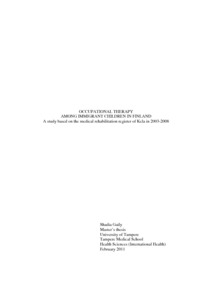OCCUPATIONAL THERAPY AMONG IMMIGRANT CHILDREN IN FINLAND A study based on the medical rehabilitation register of Kela in 2003-2008
GAILY, SHADIA (2011)
GAILY, SHADIA
2011
International Health, HES
Lääketieteen yksikkö - School of Medicine
This publication is copyrighted. You may download, display and print it for Your own personal use. Commercial use is prohibited.
Hyväksymispäivämäärä
2011-03-22
Julkaisun pysyvä osoite on
https://urn.fi/urn:nbn:fi:uta-1-21234
https://urn.fi/urn:nbn:fi:uta-1-21234
Tiivistelmä
Children in immigrant families represent an important and growing group of the overall child population in Finland. The success of immigrants and their children is dependent on the extent to which they are welcomed, included and integrated. So far, there is little information available on immigrant children in need of special support and whether the need of special support is being satisfied. Only few qualitative studies have been conducted on the rehabilitation needs of immigrants and the abilities of the existingrehabilitation services to respond to these needs.The aim of this study was to describe occupational therapy among immigrant children in Finland. The study aimed at describing the extent to which immigrant children and their families have applied for Kela compensated occupational therapy, recognizing possible differences in the compensation decisions of Finnish and immigrant children, studying the reasons for receiving occupational therapy and examining the population proportion of immigrant and Finnish children receiving occupational therapy.The study was performed as a register-based study linking the disability allowance register and the rehabilitation register of The Social Insurance Institution of Finland (Kela). The research method was quantitative. The main theory of the Thesis was threedimensional and founded on a rights-based thinking that immigrant origin children have a right to occupational therapy based on either the right to integration, right to services for disabled or the right to basic services.During the study period 2003-2008, 1 126 Kela compensated interventions of medical rehabilitation were given to immigrant origin children. Of these, 228 interventions were occupational therapy. The results of the study showed that immigrant children and families have increasingly applied for Kela compensated occupational therapy. However, the applications of immigrant children and families were rejected more often than the applications of Finnish children. Among all children the primary reason for receiving occupational therapy was mental and behavioral disorders. The average annual number of children receiving disability allowance, medical rehabilitation and occupational therapy per 1 000 was greater among Finnish children than among immigrant children.Discussion is needed on what the current service system can do to ensure equal treatment for equal need and how immigrant families can be supported to secure equal opportunity for rehabilitation and fair application procedures.
Asiasanat:occupational therapy, medical rehabilitation, immigrant children
Asiasanat:occupational therapy, medical rehabilitation, immigrant children
